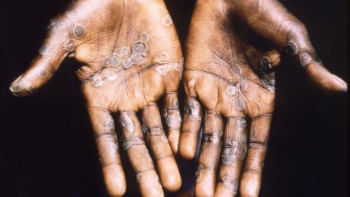What you need to know about monkeypox

The disease can be prevented by avoiding contact with the diseased person, practising strict personal hygiene maintenance, especially handwashing with soap and water, and wearing a mask. Isolate infected patients from others who could be at risk for infection.
According to the BBC, over 80 cases of monkeypox have been verified in at least 12 countries, including the United States, Canada, Australia, the United Kingdom, Spain, Portugal, Germany, Belgium, France, the Netherlands, Italy, and Sweden recently. The situation is evolving and the World Health Organisation (WHO) expects there will be more cases of monkeypox identified as surveillance expands in non-endemic countries. Immediate actions focus on informing those who may be most at risk for monkeypox infection with accurate information, in order to stop further spread.
The monkeypox virus is a rare disease caused by infection with the monkeypox virus, and this virus is similar to the smallpox virus and cowpox virus. The first human cases of monkeypox were recorded in 1970 in the Democratic Republic of the Congo. The natural reservoir of monkeypox remains unknown. However, African rodents and non-human primates (like monkeys) may harbour the virus and infect people.
In humans, the symptoms of monkeypox are similar to but milder than the symptoms of smallpox. Monkeypox begins with fever, headache, muscle aches, and exhaustion. The main difference between the symptoms of smallpox and monkeypox is that the monkeypox causes lymph nodes to swell (lymphadenopathy) while smallpox does not. The incubation period for monkeypox is usually 7−14 days but can range from 5−21 days.
The illness begins with fever, headache, muscle aches, backaches, swollen lymph nodes, chills, and exhaustion; within 1 to 3 days, sometimes long after the appearance of fever, the patient develops a rash, often beginning on the face and then spreading to other parts of the body. Lesions progress through the following stages before falling off: macules (flat, reddened area in a skin rash), papules (raised area is a skin rash), vesicles (blisters on skin), pustules (pus), and scabs (a protective tissue covering that forms after your skin has been damaged). The illness typically lasts for 2−4 weeks. In Africa, monkeypox has been shown to cause death in as many as 1 – 10%.
Transmission of monkeypox virus occurs when a person comes into contact with the virus from animals, humans, or materials contaminated with the virus. The virus enters the body through broken skin, respiratory tract, or mucous membranes (eyes, nose, or mouth).
Currently, there is no proven, safe treatment for monkeypox virus infection. However, the treatment can be based on symptoms. To control a monkeypox outbreak in the United States, the smallpox vaccine, antivirals, and vaccinia immune globulin (VIG) can be used. The smallpox vaccine may protect against the infection to some extent.
The disease can be prevented by avoiding contact with the diseased person, practising strict personal hygiene maintenance, especially handwashing with soap and water, and wearing a mask. Isolate infected patients from others who could be at risk for infection. Use personal protective equipment (PPE) when caring for patients. No monkeypox cases have been detected in Bangladesh yet, Bangabandhu Sheikh Mujib Medical University (BSMMU) says. However, Bangladesh declared a health alert amid rising cases of Monkeypox across the world.
As we maintained in the COVID-19 infection, personal hygiene is sufficient to protect us from monkeypox infection. Furthermore, visitors from other countries should be quarantined for a few days. Passengers arriving from affected countries must be subjected to increased monitoring and health screening at all international airports and land ports. Nothing to be panicked about. Take care; stay safe and healthy.
The author works at Community Based Medical College (CBMC), Mymensingh. Email: [email protected]

 For all latest news, follow The Daily Star's Google News channel.
For all latest news, follow The Daily Star's Google News channel. 









Comments